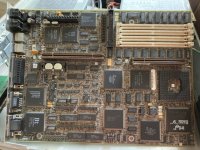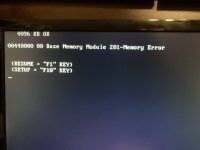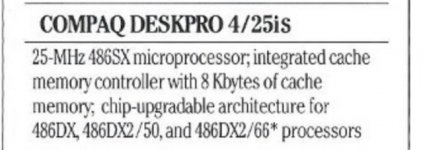Upcoming Events:
- VCF South West - June 14 - 16, Davidson-Gundy Alumni Center at University of Texas at Dallas
- VCF West - Aug 2 - 3, Computer History Museum, Mountain View, CA
- VCF Midwest - Sept 7 - 8 2024, Schaumburg, IL
- VCF SoCal - Mid February 2025, Location TBD, Southern CA
- VCF East - April 2025, Infoage Museum, Wall NJ
-
Please review our updated Terms and Rules here
- Forums
- Companies
- IBM Computers, PCs, Clones and Descendants
- PCs and Clones (XT and early AT class machines)
You are using an out of date browser. It may not display this or other websites correctly.
You should upgrade or use an alternative browser.
You should upgrade or use an alternative browser.
RAM for Compaq Deskpro 4/25is (486sx)
- Thread starter thenzero
- Start date
T-R-A
Veteran Member
Likely 60ns, FPM parity. No idea what the max capacities on it would be. I'd suspect 32MB (8MB SIMMs).
Yes, these early Compaq systems need 36-bit parity modules. Can also easily been seen by the on-board memory: 9 chips. Without parity, it would only have 8 chips.
Quite hard to find in sizes that it can use. It must be FPM, not EDO. Also not larger than 8 MB. Had one of these Deskpros as well.
Quite hard to find in sizes that it can use. It must be FPM, not EDO. Also not larger than 8 MB. Had one of these Deskpros as well.
T-R-A
Veteran Member
I still have several. All of them (386/486/early P1) were solid machines. Wasn't keen about softpaqs or the limitations of Compaqs bios. But never had any issue otherwise.
No, I sold it. Didn't like its limitations and I have so many other PCs already.Out of curiosity do you still have your Deskpro?
I had a little trouble getting the sound working in windows 3.1 until I found out about the WSS drivers on vogons. Working well now. I would like to find a coprocessor for it, did either of y’all ever look into that? Info is somewhat scarce.
The 486sx has no separate coprocessor. You install a 487, which is just a DX in disguise and takes over the whole system. It's also possible to use a normal DX instead, but it depends on whether or not the mainboard has a jumper to allow that. If not, you'd have to do a small mod to the socket.
Since almost nothing uses the FPU anyway, it's nothing to worry about.
Since almost nothing uses the FPU anyway, it's nothing to worry about.
The 486sx has no separate coprocessor. You install a 487, which is just a DX in disguise and takes over the whole system. It's also possible to use a normal DX instead, but it depends on whether or not the mainboard has a jumper to allow that. If not, you'd have to do a small mod to the socket.
Since almost nothing uses the FPU anyway, it's nothing to worry about.
Oh yeah I think I read about that somewhere. Well it was about someone downgrading from the dx.
The reason I was thinking about it was because some game I tried to run recently errored out with a message about needing the fpu. Can’t remember which game it was. Not a big deal but I may look around for that dx upgrade.
T-R-A
Veteran Member
Do you happen to know if the socket for the 487 is pga169?
Yes, it is:
https://www.cpu-world.com/CPUs/80487/index.html
But in all honesty, if DOS gaming is what you're after, then a SX or DX 25 is pretty kludgy. Look around for something more like a generic DX66 or early P1 (75-90 MHz). Preferably with a turbo switch for older games. While I stated that the early Deskpros were very reliable, they're not much for gaming. IDE drives are limited to 540MB (without a special interface card or DDO). Most of them have a dreaded DALLAS RTC chip, and adding anything in available drive bays requires a special drive rail .
Yes, you can even put an DX4-100 Overdrive into the socket. Note however that you need the correct version. There is one for the 486 and one for the 487 socket.
Is the dx2odp66 the correct one?
Yes, if it is "ODP" and not "ODPR", it's the correct one. That goes into the 487 socket.
Cool thanks.
Yes, these early Compaq systems need 36-bit parity modules. Can also easily been seen by the on-board memory: 9 chips. Without parity, it would only have 8 chips.
Quite hard to find in sizes that it can use. It must be FPM, not EDO. Also not larger than 8 MB. Had one of these Deskpros as well.
Thanks again, got a 4mb fpm stick with parity off ebay for $8 and it’s working great.



